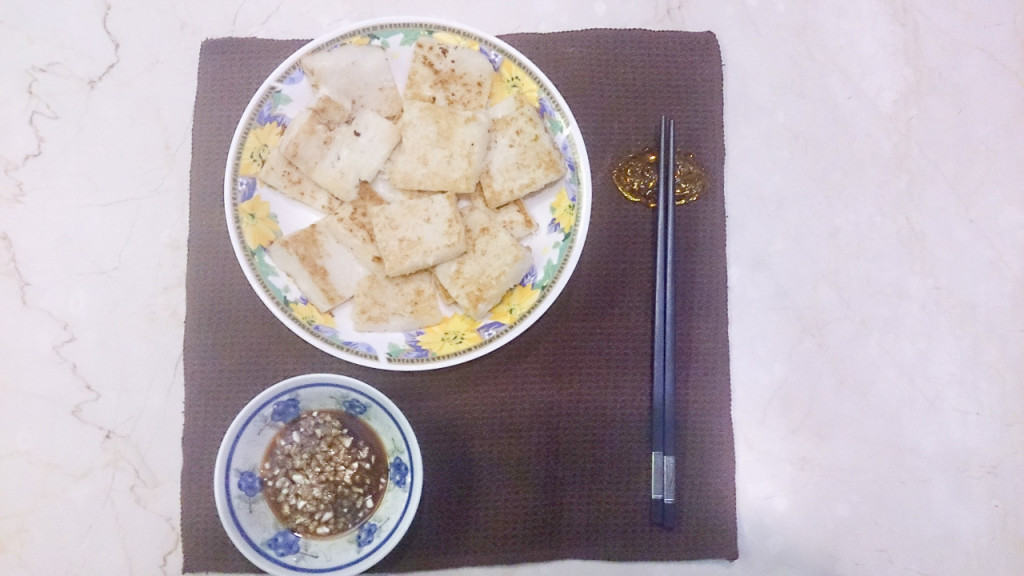
Pan-fried white radish cake with minced garlic in soy sauce. Photo: Mei-Chiao Liu
Ever since I can remember, my family has had a big plate of white radish cake on the table for lunar New Year’s Eve, sometimes steamed, sometimes pan-fried. Both sides of my family came to Taiwan in the 18th century from southern Fujian, where the dialect Hokkien is spoken. White radish in Hokkien is a homophone for “good fortune,” so families serve the dish in the hope of having a prosperous new year. Although Taiwanese Hokkien combines Quanzhou and Zhangzhou dialects, it still sounds similar, and we stick to the tradition.
Back home, the white radish cake was made by my grandmother on my mother’s side. She was born in 1939, and at 18 married my grandfather, the firstborn son among nine siblings. That meant that she was responsible to take care of the whole family, and could not say no to any request from her mother- and father-in-law. My mother grew up in a big, agricultural family, which had two acres of paddy field for rice growing, dozens of chickens, ducks, geese, around ten pigs, five goats, and two water buffaloes. After getting married, my grandmother started to make white radish cake every year for Lunar New Year’s Eve.
Taiwan is in the subtropical climate zones; Lunar New Year happens to be right after the second rice harvest of the year, and winter is the season for white radish, which is extremely sweet and juicy. My grandma used to use a stone mill to grind basmati rice into a thick liquid, and then she added the shredded white radish into the liquid, mixed it well, and poured the liquid into a huge round bamboo steamer lined with a dampened cloth coated with oil. Next, she heated the steamer on a hearth, over firewood in the brick-lined fireplace. With industrialization, that changed: today, my grandmother uses a rice milling machine, a metal steamer, and a gas heater.
It is a famous white radish cake, recognized for its quality by a chef at a well-known local restaurant (卦山大飯店) near Pa-Gua mountain scenic park in Changhua, where my grandmother worked for ten years to help support her family. One day, the chef was sick and couldn’t come to work. Nobody in the kitchen had confidence to make a white radish cake except for my grandmother, who volunteered. People loved the white radish cake she made, and she got permission to work as a woman chef in the kitchen. She is almost 80, and still insists that she wants to make her own white radish cake. “The secret is the amount of water,” she said, proudly. I think she likes to see us go back to her place to pick up the cake and be able enjoy it during Lunar New Year. It is one way for her to gather us together and show her love.
White radish cake is not only for new year anymore, but has become a very common everyday dish throughout east Asia as well as south Asia, with several ways of preparation and sauce in different countries. In Taiwan we make it with soy sauce, and even have it for breakfast. Most of them are now made by machines in factories, so the texture and the taste is different from the one from my grandma. They are incomparable. Every year, I get very excited at the prospect of enjoying my grandma’s handmade radish cake, it tastes “real;” by that I mean I can actually feel that it’s less processed, and I can taste the sweetness of a bunch of fresh shredded white radish inside. People can have a hard time if they try to find even a little piece of shredded white radish cake in the ones sold in stores.
This Lunar New Year, I had to stay in New York City. Together with some Taiwanese friends, we had a celebration on our own. We discovered some nice places in Chinatown, but I could not find a white radish cake made the same way. They are mostly factory-made Cantonese style in a dim sum restaurant with salty dried mini shrimp and hashed smoky cured pork in it. Not that they are bad, it’s just different from the simple, natural and fresh recipe I miss.

Your Comments